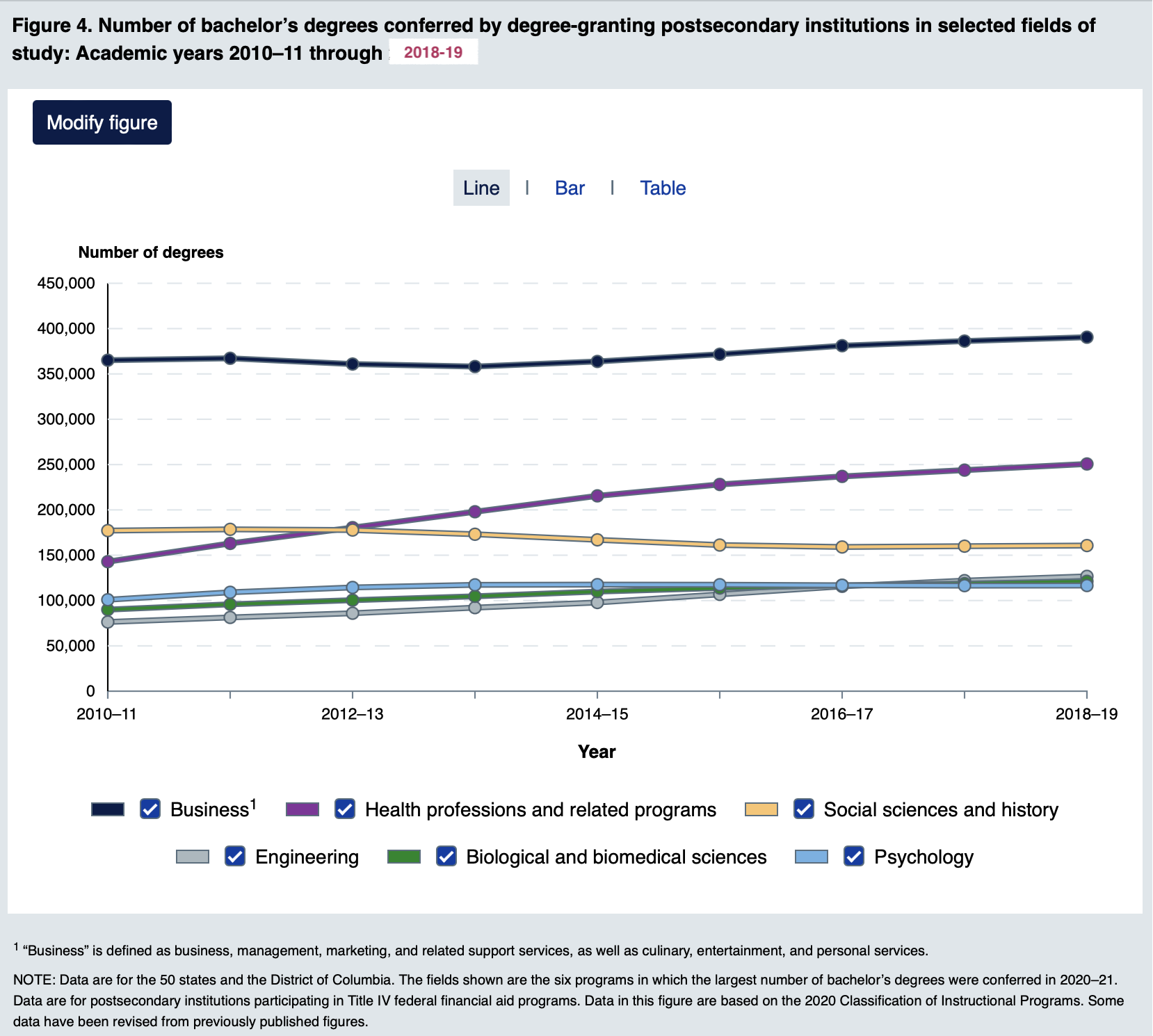
by James C. Sherlock
Tastes change, and with them trends.
Between fall 2010 and fall 2021, total undergraduate enrollment in degree-granting postsecondary institutions in America decreased by 15% percent (from 18.1 million to 15.4 million students).
In Virginia’s 4-year public colleges and universities, the drop was 8% in that same period, right at the national average for state schools.
Virginia’s HBCU’s, except for the highest ranked, Hampton University, have fought the trend and increased their student populations dramatically recently.
The Great Recession baby bust arrives as a freshman student cliff in 2025.
National trends. The National Center for Education Statistics (NCES) data on enrollment in undergraduate majors in 4-year public and private institutions of higher education (IHEs) show significant shifts in majors between 2010 and 2023.
There are winner and loser programs, with implications for staffing and perhaps offering a data basis for my magnet schools suggestion.
Between 2010 and 2023, undergraduate majors in:
- liberal arts and social sciences continued to decline;
- engineering majors have been in serious decline since 2019;
- health professions and related programs, having seen huge increases between 2010 and 2019, and physical sciences with smaller increases in those same years, since then are in decline;
- technology continues to gain, even faster since 2019, possibly signaling a shift from engineering to technology majors for the same types of students;
- Psychology, flat between 2010 and 2019, is in a major uptrend since.
Adjustments within higher education are clearly necessary to accommodate the declines in student populations, the coming student cliff and shifting educational preferences by students.
Rational adjustments are clearly identifiable but rarely seen in practice. Because administrations and faculty oppose them. The ramifications:
- Spending, infrastructure and personnel costs and prices rise in the face of declining demand;
- The differences are funded, except in the richest schools, with institutional borrowing and most have seen rises in student loans;
- Public institutions ask for more public money in the absence of rational adaptation strategies;
- Boards are in place to make the appropriate changes happen but have proven reluctant to do so.
That will all stop one way or another – either in planned adaptive changes or in train wrecks.
2010-2019. In a graphic adjusted to show bachelor degrees granted between 201o and 2019 in the most popular majors, business was the largest, health professions by far the fastest growing, and social sciences and history the only losers.
2019 – 2023. In an NCES table with a more specific breakout of majors between 2019 and 2023, significant changes are illustrated.
Biggest percentage gainers:
- CIP 29 – Military Technologies and Applied Sciences – Up 216% to 6,804
- CIP 12 – Personal and Culinary Services – up 149% to 13,905
- CIP 11 – Computer and Information Sciences and Support Services – up 131% to 595,212
- CIP 10 – Communications Technologies/Technicians and Support Services – up 131% to 24,882
Biggest number gainers:
- CIP 11 – Computer and Information Sciences and Support Services – up 140,135
- CIP 42 – Psychology – up 64,913
- CIP 50 – Visual and Performing Arts – up 19,020
The biggest percentage losers:
- CIP 19 – Family and Consumer Sciences/Human Sciences – down 20.5%
- CIP 16 – Foreign Languages, Literatures, and Linguistics – down 18.5%
- CIP 23 – English Language and Literature/Letters – down 17.7%
Biggest number losers:
- CIP 24 – Liberal Arts and Sciences, General Studies and Humanities – down 127,302
- CIP 14 – Engineering – down 54,968
- CIP 51 – Health Professions and Related Clinical Sciences – down 53,900
- CIP 45 – Social Sciences – down 53,129
See the NCES website for definition of CIP codes and courses of study within each CIP code.
Bottom line. In Virginia, we have inherited one of the best and most diverse state college systems in America. It is ours to preserve and improve.
We see very significant shifts in student numbers and student demands for education in specific majors. It is impossible for me to determine how well individual Virginia colleges and universities plan to adapt.
In the public ones, their Boards of Visitors should be on top of what are for some existential issues. But the taxpayers, and thus the state, have a role if the Boards are not executing theirs.
Darwinian change. We clearly see cannibalization of the smallest and less wealthy state schools by the largest and richest.
If we wish to maintain and improve the breadth of choices of college experiences among Virginia’s 15 state-supported 4-year colleges and universities,
- cannibalization will stop at the direction of the state; and
- increases of the attractiveness of the other institutions will be addressed by their boards with the assistance of the state.
If we do not care about the outcome, we need only do nothing.
Rational change. Careful but real change is required in an environment in which the overall total number of undergraduate students has been flat-to-declining, will soon decline more, and tastes for majors have shifted.
In a rational approach:
- colleges would expand departments to meet growing course demands and address declines with departmental cutbacks;
- they would cut administrative positions to address massive inefficiencies introduced over 40 years of hyper-expansion, and ongoing reductions in students;
- they would stop building and both maintain and consolidate within existing infrastructures; and
- some would look to entirely new approaches to attracting students.
Some of those adjustments are happening at some schools. Others have failed to change and have closed their doors, or will soon.
Sweet Briar offers a wonderful story of a successful rescue by alumnae after the failure of its board. But the rescue was enabled by its very small size and thus will likely prove a one-off.
Community colleges, having experienced even more significant recent student declines than the 4-year schools in Virginia, are historically nimble. They will need to be.
But if rational change is happening in Virginia’s state-supported 4-year institutions generally, I have missed it.


Leave a Reply
You must be logged in to post a comment.